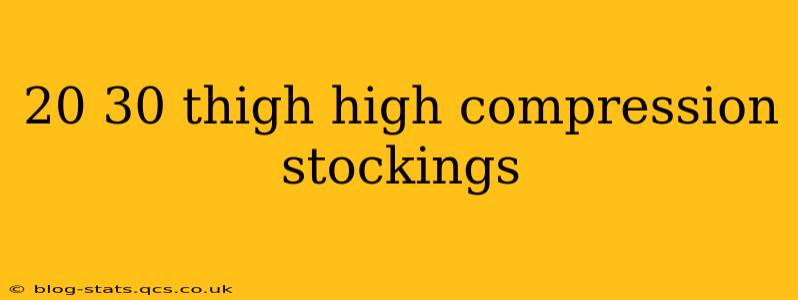Finding the Perfect 20-30 mmHg Compression Stockings for Thigh High Support
Finding the right compression stockings can be a game-changer for managing various leg conditions and promoting overall leg health. This guide focuses specifically on thigh-high compression stockings with a compression level of 20-30 mmHg, explaining what they are, who benefits from them, and how to choose the best pair for you.
What are 20-30 mmHg Thigh High Compression Stockings?
20-30 mmHg thigh-high compression stockings provide graduated compression, meaning the pressure is strongest at the ankle and gradually decreases as it moves up the leg towards the thigh. This targeted pressure helps improve blood circulation, reducing swelling and fatigue in the legs. The "thigh-high" designation simply means the stocking extends to the upper thigh, offering more comprehensive support than knee-high options. This higher level of compression is particularly beneficial for individuals experiencing moderate to severe leg discomfort or those requiring more substantial circulatory support.
Who Benefits from 20-30 mmHg Thigh High Compression Stockings?
This level of compression is often recommended for individuals experiencing a variety of conditions and situations, including:
- Mild to Moderate Varicose Veins: The compression helps to improve blood flow, reducing the appearance and discomfort of varicose veins.
- Edema (Swelling): The graduated compression assists in reducing fluid retention, minimizing swelling in the legs and ankles.
- Post-Surgery Recovery: Following certain leg surgeries, compression stockings are frequently prescribed to help reduce swelling and promote healing.
- Long Periods of Standing or Sitting: Individuals who spend extended hours on their feet or sitting may find relief from leg fatigue and discomfort using compression stockings.
- Pregnancy: Many pregnant women experience leg swelling and discomfort. Compression stockings can help alleviate these symptoms.
- Deep Vein Thrombosis (DVT) Prevention: While not a cure, compression stockings can play a supportive role in reducing the risk of blood clots, particularly after surgery or during periods of prolonged immobility. (Always consult with your doctor for DVT prevention strategies.)
What are the differences between compression levels?
Compression stockings are available in various compression levels, measured in mmHg (millimeters of mercury). The level you need depends on your individual needs and medical condition. Generally:
- 8-15 mmHg: Offers light support, ideal for everyday wear and mild discomfort.
- 15-20 mmHg: Provides moderate support, suitable for mild to moderate leg fatigue and swelling.
- 20-30 mmHg: Offers moderate to firm support, often recommended for managing varicose veins, edema, and post-surgical recovery.
- 30-40 mmHg: Provides firm support, typically prescribed for severe conditions like lymphedema or venous ulcers. (Requires a doctor's prescription.)
It's crucial to note that choosing the correct compression level is essential. Always consult with your doctor or a medical professional to determine the appropriate level for your specific needs.
How do I choose the right size and fit?
Proper sizing is critical for effective compression and comfort. Manufacturers typically provide detailed sizing charts based on your height and weight, or leg measurements. Choose a size that fits snugly but not too tight – it should be comfortable to wear all day. Look for stockings made from breathable materials to maximize comfort.
How long should I wear them?
The recommended wearing time depends on individual needs and medical advice. Some individuals may need to wear them all day, while others may only need them during periods of activity or when experiencing discomfort. Always follow your doctor's or medical professional's guidance.
How do I care for my compression stockings?
Proper care prolongs the life of your compression stockings and ensures they maintain their effectiveness. Always follow the manufacturer's care instructions, which usually involve hand washing in cool water and air drying. Avoid using harsh detergents or bleach.
Where can I buy 20-30 mmHg thigh-high compression stockings?
You can find a wide variety of 20-30 mmHg thigh-high compression stockings at medical supply stores, pharmacies, and online retailers. Be sure to check reviews and compare prices before making your purchase.
This information is for educational purposes only and does not constitute medical advice. Always consult with a healthcare professional before using compression stockings, especially if you have underlying medical conditions. They can help you determine the appropriate compression level and ensure you're making the best choices for your leg health.
